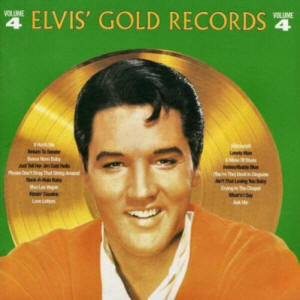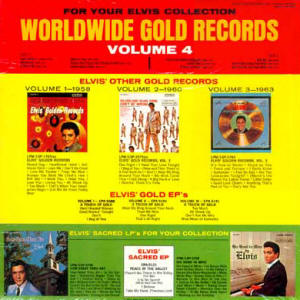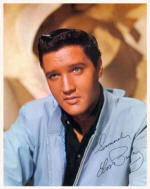Verdict
Back in 1968 the album was nothing but a collection of old songs in a stale looking packaging. From today's point of view it's a compilation of fine, early 1960s popmusic.
![]()
(C) RCA Records
The ultimate site about the king of the analogue age


After half a decade RCA Victor continued their series of "Gold" albums and released a fourth volume in January 1968. On February 3rd "Elvis' Gold Records - Volume 4" entered the "Top LPs Chart", where it stayed for 22 weeks and peaked at number 33. In its initial sales period the record sold 300,000 copies, in 1992 the RIAA honored the domestic sales with a Gold Award. Worldwide 2.5 million copies were retailed, which translates to 375 million paid streams of the complete album or 3.75 billion paid streams of individual tracks. Compared to his recent soundtrack albums the latest incarnation of the "Gold" series was a success, but nevertheless it sold just a quarter of the first volume (1958) and half of the previous edition (1963).
In 2016 the complete Presley catalogue was restored and remastered by Vic Anesini for a boxed set of 60 compact discs called "The Album Collection". Sony Music Entertainment provides the streaming platforms with the same versions of the individual albums (some of them offering bonus tracks), albeit in 24 bit/90 khz flac. That means, if the platform of your choice supports high resolution audio, you can enjoy the tracks in the same quality Sony used to scan and master them. On Spotify, which has a market share of approximately 30% and is the only platform that publishes streaming figures, "Elvis' Gold Records - Volume 4" accumulates 312 million streams with 130,000 requests per day. So today the album is a strong item of the Presley catalogue, but still less popular than the 3rd installment of the series (447 million streams) and lightyears away from the first one (2.2 billion streams).
The cover design was reminescent of "Elvis' Golden Records - Volume 3", but instead of using a current picture RCA opted for a photo made in 1965. Unfortunately the singer already had looked a bit old-fashioned back then. The backside advertised the other "Elvis' Golden Records" albums as well as the "A Touch Of Gold" extended players. Besides that, his two gospel albums and the gospel ep "Peace In The Valley" were advertised.
To boost the sales RCA Victor also included a photo card. Once again the label refused to present the current Elvis and preferred to show a promo picture made in 1962 in connection with the movie "Girls! Girls! Girls!".

Because Elvis' singles hadn't sold all that well in the past few years, RCA this time didn't just ignore the official certification status of the tracks, but also didn't care for the domestic sales. The hits on the previous "gold" albums had at least sold a million copies in the US, but now it was enough if they had sold a million copies worldwide. Besides that, one of the goals was to collect tracks, that were not available on albums. For example, the b-side "Witchcraft" was used on this album, because the hit "Bossa Nova Baby" was available on the longplayer "Fun In Acapulco". A best-seller like "Crying In The Chapel" was left out, because it had been used as a bonus track on the album "How Great Thou Art". In total this collection of songs has a running time of 29:09 minutes.
In 2016 Follow That Dream Records released a collector's edition of "Elvis' Gold Records - Volume 4". For a review tap HERE.
Love Letters
The ballad was written by Victor Young and is the titel song of the movie "Love Letters", released in 1945. Young recorded an instrumental version with his orchestra in January of that year, later Edward Heyman added lyrics. Dick Brown was the first to record it that way, later he was followed by many other stars. Perry Como and Elvis Presley even recorded "Love Letters" twice. Como in 1945 and 1958, Presley in 1966 and 1970. In 1976/77 Elvis also performed the song live on stage. The recording on this album was made on May 26, 1966 at RCA Studio B in Nashville/Tennessee. The king needed nine takes to get the song right. "Love Letters" is a strong ballad and Elvis performs it extremely well. Neither his re-recording, nor any of his live performances match the beauty of his original version. In 1966 "Love Letters" was released on the flipside of "Come What May", but it soon turned out, that it was the favorite of the fans, critics and radio stations. On the "Hot 100" it peaked at number 19, worldwide the single sold 1.25 million units.
WitchcraftElvis taped "Witchcraft" on May 23, 1963 for a new album, which finally was canceled due to the release of the greatest hits compilation "Elvis' Golden Records - Volume 3" and the "Fun In Acapulco" soundtrack. RCA released the track on the b-side of "Bossa Nova Baby", which reached number 8 of the Billboard Charts and sold two million copies. In 1971 it could also be found on the boxed set "The Other Sides - Worldwide Gold Award Hits Volume 2". In 1968 the label opted for "Witchcraft", because "Bossa Nova Baby" was available on the "Fun In Acapulco" soundtrack.
It Hurts MeThe same applies to "It Hurts Me". In 1964 it had been the flipside of "Kissin' Cousins", which was still available on the accordant soundtrack album. The 45 had moved two million copies and charted at number 12 of Billboard's "Hot 100". The ballad was written by Joy Byers and Charles E. Daniels and was recorded for the first time by Jerry Jackson. But because his version stayed in the vaults since 1990 Elvis can be considered the original artist. He recorded the song on January 12, 1964 at RCA Studio B in Nashville/Tennessee within five takes. Without doubt "It Hurts Me" also would have made a great a-side, but Colonel Parker wanted to promote the movie and his client consented. In 1971 "It Hurts Me" was re-released on "The Other Sides - Worldwide Gold Award Hits Volume 2".
What'd I SayIn this case RCA could have included "Viva Las Vegas" and "What'd I Say", because both tracks were not available on an album at the time. But they left out the title song of Elvis' most successful motion picture and put just "What'd I Say" on the album. The song was recorded on August 30, 1963, Elvis needed four takes to reach a satisfactory result. The song was written by Ray Charles, who scored his first major hit with it in the summer of 1959. Back in those days Elvis would have produced a steaming r&b performance, too, but in 1963 the result wasn't much more than an uptempo popsong with the backup singers sounding a tad hysterical.
Please Don't Drag That String AroundThe singer is desperate, because his loved one keeps him dangling on a string. But while this story would have been presented by the Elvis of the 1970s in form of a mournful ballad, his younger self wraps it in an uptempo popsong. "Please Don't Drag That String Around" was written by Otis Blackwell and Winfield Scott, Elvis recorded it on May 26, 1963 at RCA Studio B in Nashville/Tennessee within six takes. In the summer of 1963 it appeared on the b-side of "(You're The) Devil In Disguese", in 1971 "Please Don't Drag That String Around" could also be found on the boxed set "The Other Sides - Worldwide Gold Award Hits Volume 2"
Indescribably BlueIt finally happens, here we get the first legit a-side! "Indescribably Blue" / "Fools Fall In Love" was released in early 1967, peaked at number 33 and sold a million copies worldwide. Because Elvis fell ill on June 10, 1966 he stayed in his hotel suite while the band recorded a music track. Two days later he put his voice on the tape and needed two takes. The ballad was written by Darrell Glenn and recorded by the king at RCA Studio B in Nashville/Tennessee. In the song the narrator was left by his lady and expresses his pain in big voiced and somewhat turgid style. Even though Elvis made a timing mistake on the thrid line I like "Indescribably Blue" very much. The king uses his voice to the full extent and sings with a lot of emotion.
(You're The) Devil In DisguiseBill Giant, Bernie Baum and Florence Kaye wrote a lot of mediocre movie songs for Elvis, but this one is neither a movie tune nor mediocre. In fact, it's a very good popsong. The loved one of the singer looks like an angel, but he knows that she's not faithful at all. Florance Kaye came up with the title as Giant and Baum called her daughter an angel. The trio thought it was great and created a song around the expression "devil in disguise". Elvis recorded it on May 26, 1963 at RCA Studio B in Nashville/Tennessee and needed six takes to do so. As mentioned before, "(Your're The) Devil In Disguise" was released in the summer of 1963 with "Please Don't Drag That String Around" on the b-side. On the Billboard Charts it peaked at number 3, worldwide RCA retailed 2.7 million units.
Lonely ManThis is a b-side again. This time the hit, it was the mega seller "Surrender, even had already been released on "Elvis' Golden Records - Volume 3". Due to the lack of new successful singles, RCA simply allocated one of the six million sold units to "Lonely Man". Besides that, the track had never appeared on an album before and might be an incentive to buy this one. In 1971 RCA re-released the song once more, this time on the boxed set "The Other Sides - Worldwide Gold Award Hits Volume 2".
A Mess Of BluesWith the song by Doc Pomus and Mort Shuman the stunt was repeated. Back in 1960 it had been the flipside of "It's Now Or Never", which also had appeared on the third volume of the "Gold" series. Elvis taped "A Mess Of Blues" within five takes on March 20, 1960 at RCA Studio B in Nashville/Tennessee. RCA Victor later also released the song on the boxed set "Worldwide 50 Gold Award Hits - Volume 1" (1970).
Ask MeThe original version was an Italian ballad named "Io". It was written by Domenico Modugno, who was also the first one to record and release it in 1958. Bill Giant, Bernie Baum and Florence Kaye wrote English lyrics and turned it into "Ask Me". The quiet, organ-carried ballad demonstrated a more mature side of the singer and meets my taste, too. In 1964 "Ask Me" was released on the b-side of "Ain't That Loving You Baby", but turned out to be more popular and charted higher. Worldwide the single sold 2.3 million copies. In 1971 "Ask Me" was re-released on the second volume of the gold boxes ("The Other Sides - Worldwide Gold Award Hits Volume 2").
Ain't That Loving You BabyEven though the single was released in late 1964, Elvis already had recorded the song on June 10, 1958 at RCA Studio B in Nashville/Tennessee. After eleven attempts without a satisfactory result the king simply decided to file "Ain't That Loving You Baby" away. When the label searched for unreleased tracks six years later, they selected take 4 as the master and released it after Elvis had given his permission. Later the song could also be found on the boxed set "Worldwide 50 Gold Award Hits - Volume 1" (1970). The rocker was written by Clyde Otis and Ivory Joe Hunter and released for the first time in 1956 by Eddy Riff. "Ain't That Loving You Baby" is a great track, much better than most of the songs Elvis was recording in the mid-sixties.
Just Tell Her Jim Said Hello
In 1971 this song appeared on the second gold
box, the first release was in 1962 on the
backside of "She's Not You". On the "Hot 100"
the song became a number 5 hit and sold 3.5
million units. RCA had used "She's Not You" on
the album "Elvis' Golden Records - Volume 3",
now they once again allocated a million copies
to the b-side to have a reason for releasing it
here. Another reason was, of course, that "Just
Tell Her Jim Said Hello" had never been included
on any other long player before.
When the narrator spots his former girlfriend,
he feels the urge to confess that he still loves
her, but decides to have greetings conveyed to
her instead. The song was written by Jerry
Leiber and Mike Stoller, Elvis recorded it on
March 19, 1962 at RCA Studio B in
Nashville/Tennessee and needed 6 takes to get it
right. It is said that he regarded "Just Tell
Her Jim Said Hello" to be the stronger track,
but finally was convinced that "She's Not You"
had the greater appeal for the radio stations.
Back in 1968 the album was nothing but a collection of old songs in a stale looking packaging. From today's point of view it's a compilation of fine, early 1960s popmusic.
![]()
(C) RCA Records